With its warm, tropical climate, Ecuador is a perfect home for reptiles who love to relax and soak in the sun. Although the majority of Ecuador’s reptiles can be found in the Amazon and its Pacific coastal plains, some snakes and lizards can also be found in the higher páramo regions.
Around 350 species of reptiles can be found in Ecuador. This number predominately includes snakes with 210 species as well as 20 species of turtles. While the Galápagos may have some of the best known reptiles with its Giant Tortoises and three unique endemic species of iguanas, mainland Ecuador’s reptiles are impressive in their own right. With representatives like the green anaconda, the largest snake in the world, coasting through the Amazon basin, Ecuador’s reptiles are a definite force amongst the other wildlife.
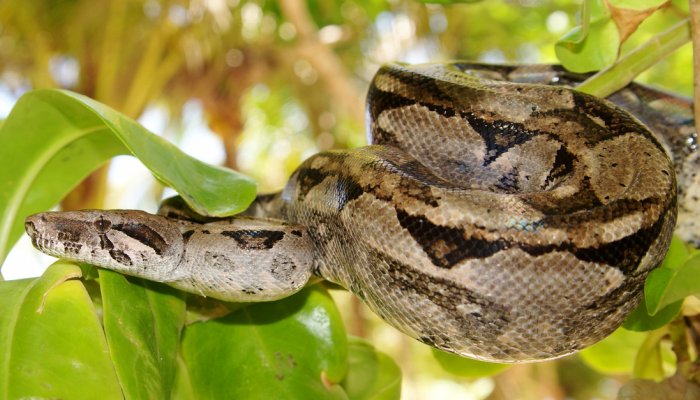
BOA CONSTRICTOR
Boas have much in common with their anaconda cousins. Boas, too, kill their prey by wrapping their long, muscular bodies them and ultimately swallowing them whole. They are also strong swimmers, although they prefer dry land more. They stay close to the ground, inhabiting hollowed-out logs or burrows abandoned by their previous animal owners. However, boa constrictors could never be mistaken for the significantly larger anacondas. Boas reach around 13 feet and weigh around 100 pounds—over 400 pounds lighter than an anaconda.
Even if they were the same size as anacondas, boas would be recognizable by their ornate skin. Boa constrictors can come in a variety of outfits. Depending on their habitat, they can be colored red, yellow, tan, or green or patterned with diamonds, circles, ovals, or irregular lines. With these different skins, they can be camouflaged in a variety of environments. Of course, their exotic skin has also caused them to be targeted by hunters who covet the unique scales throughout history.
FUN FACT:
Recent studies have brought into question the long-held belief that boa constrictors suffocate their prey to death. Their notorious “death squeeze” may actually be used to constrict their prey’s blood flow, which leads to circulatory arrest. Scientists’ recent studies have promoted this conclusion, claiming that the speed with which victims die does not match the lengthy death of suffocation. Rather, results show cardiac arrest and lack of blood in the brain. Therefore, while boa constrictors truly do have a deadly hug, their hug is most likely deadly for a different reason than presumed.
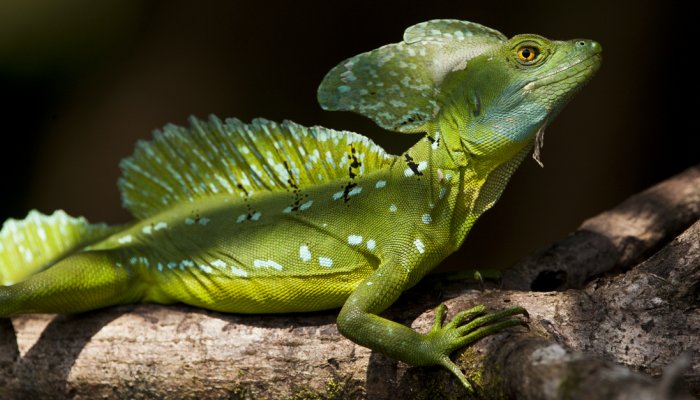
BASILISK
Basilisks are relatively small lizards that differ somewhat from the mythical reputation that developed from their European and Mediterranean cousins hundreds of years before South America was explored. According to legend, basilisks are the kings of the serpents—a status revealed in their name which translates to “little king” in Greek. They have the reputed ability to kill at a glance and leave a wake of venom—a fable that has been passed down through history and continues to be a staple in current pop culture creations such as Harry Potter.
In truth, these small lizards are not frightful, they do not have a Medusa-like gaze, and as omnivores they eat the occasional bird, fish, or snake rather than attacking humans. There are four types of basilisks, with the western basilisk, otherwise known as the red-headed basilisk, being the most common within the forests of Colombia and Ecuador. However, the common basilisk and the green basilisk can also be found in the rain forests.
Related to iguanas, basilisks can range from 28 inches to 2 feet, with the smaller basilisks being Ecuador’s western basilisks. All of the basilisks share the fin-like crest that crowns their heads, no doubt a feature which lent itself to their kingly name. Males use these crests to attract future mates in an effort of peacocking. They prefer their habitats to be near the water, and so they live in tropical environments near ponds, streams, or rivers. Their preference for watery habitats is closely related to their survival skills as they often use the water as a defense mechanism. They are able to make quick escapes across the water where predators—particularly tree boas—are unable to follow quickly. They are also able to sink below the water’s surface and remain submerged for up to 30 minutes of time if cornered.
FUN FACT:
Not only are basilisks not the servants of dark lords, but they are actually known as the Jesus Christ lizard for their remarkable ability to walk on water…or run on water, we should say. The Jesus Christ lizards tend to scamper quickly away from predators rather than take a leisurely stroll.
The basilisk’s large feet have extra trimmings of skin between their toes that are able to unfurl and expand. In turn, when they slap their enlarged feet, they create an air pocket in the water that pushes the foot up in conjunction with the force of the lizard’s motion. The lizard is able to take up to 20 steps per second, and younger lizards are able to travel longer distances due to their lighter weight. When their gravity defying feet lose their potency and weight takes over, they are able to continue their journey within the water like the rest of us mere mortals.
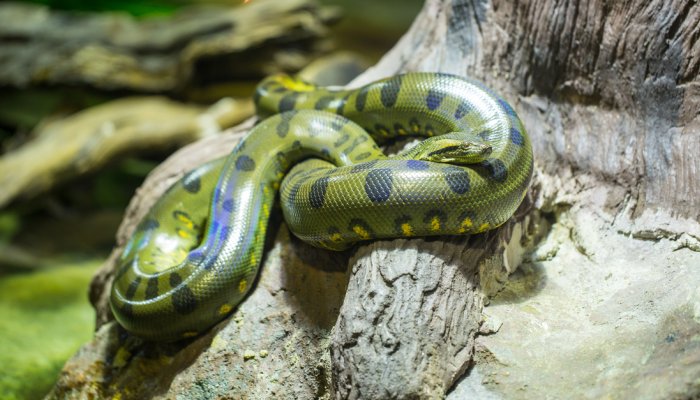
GREEN ANACONDA
The green anaconda is the largest snake in the world if its massive weight is taken into account. Although the reticulated python is slightly longer, the anaconda is almost twice as heavy with its greater girth. This “largest” snake in the world can weigh over 550 pounds, a weight that can be distributed over their 12 inch waists and 29 feet of length. In opposition to many animals, it is the female green anaconda that grows remarkably larger than the males.
Anacondas inhabit the watery environments of the Amazon and the Orinoco basins in South America. They prefer slower-moving water such as marshes, more stagnant streams, and swamps. While their mass becomes a burden on land, it does not hinder their movement in water where they swim with sleek effortlessness.
As impressively large carnivores, they have a variety in their diet that includes turtles, caimans, birds, deer, wild pigs, capybara, and the occasional jaguar. As nonvenomous constrictors, and members of the boa family, they rely on asphyxiating their prey by coiling their bodies around them. Like many other snakes, they swallow their prey whole. With large meals sitting within their stomachs, anacondas can ‘fast’ for weeks, or sometimes months, while they digest.
FUN FACT:
Unless you happen to be a male anaconda looking to procreate, the anaconda breeding ball is one ball you do not want an invitation to. When male anacondas look for a mate, they can find a frisky female already being attended to by a group of males in a mating party. Up to 12 different males can be entwined around a single female, creating the breeding ball. Scientists aren’t fully certain how the orgy hierarchy works, or if there is one, but it is clear that anacondas do not shy away from competition when mating.
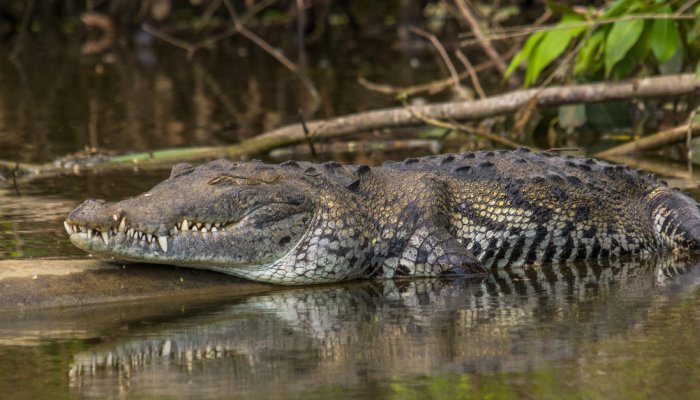
AMERICAN CROCODILE
Though the American crocodile has a wide range of habitats extending into North, South, and Central America, it is still an endangered species throughout all these territories. Those surviving populations are often found in coastal areas, and they also enjoy river systems with higher salinity as well as brackish lakes, lagoons, and mangrove swamps.
Cousins to the American alligator, it can be distinguished from the alligator by its lighter color, longer, thinner snout, and two teeth protruding from its lower jaw visible even when its mouth is closed. The American crocodile stands as the largest of the world’s crocodiles, and those inhabiting the South and Central American males growing up to 20 feet in length. The U.S. crocodiles populating southern Florida seldom grow larger than 13 feet in height, however.
Like many other reptiles, American crocodiles enjoy spending most of their days in inactivity, either resting in their self-created burrows, lounging on a bank enjoying the sun, or calmly waiting in wait for prey. Of course, basking in the sun is actually productive in a sense, as it raises the animal’s body temperature to levels required to digest their food and remain active.
Although crocodiles are opportunistic hunters, they are also strategic and known to set a trap. Although they can eat fish, crabs, frogs, snails, and even insects, they have been seen balancing twigs on top of their head to tempt birds who seek building supplies for their nests.
FUN FACT:
In some ways, crocodiles are fastidious eaters who appreciate eating at their own pace and in bite-sized pieces. If the crocodiles take down larger mammals from the shoreline, they drag the prey into the water and drown it. Once there, the crocodile grabs hold of a single body part and rolls its own body until the attached part is twisted off. As such, they are able to enjoy bite-sized pieces that are more easily ingested.
American crocodiles also do not like stuffing themselves. If the crocodile preys upon an animal too large to consume in a single meal, the crocodile finds a hiding place to store its food. They often choose an overhanging bank or a partially submerged log to serve as this storage container, and they will return to their hiding spot to resume their meal when they’re ready.
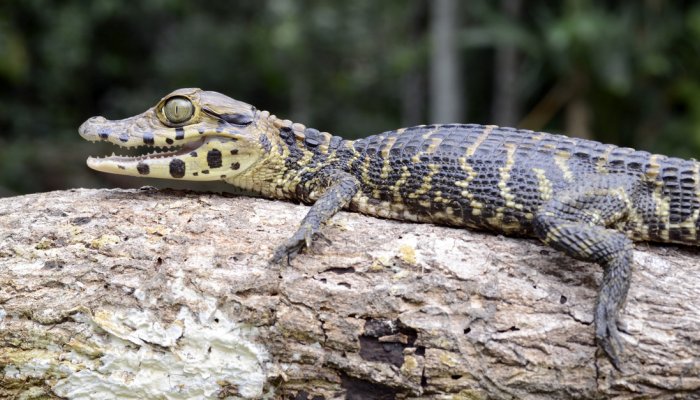
BLACK CAIMAN
Not only is the black caiman the largest of the family “Alligatoridae,” but it’s the apex predator of the Amazon basin. The black caimain can grow up to 20 feet long and while they mostly feed on fish, they also tackle larger animals such as turtles, deer, and capybara. The black caiman gets its name from its black skin, although they have yellow and white bands when they are young that fade as they mature. Their dark protective armor serves as excellent camouflage for their nocturnal hunts. Black caimans are usually nocturnal hunters as their sight and hearing are particularly good.
FUN FACT:
Black caimans were considered a critically endangered species in the 1970s, by which time they had been severely overhunted for their skins. Conservation efforts have proved successful, and the population is bouncing back. Currently, the black caiman is listed as Conservation Dependent.
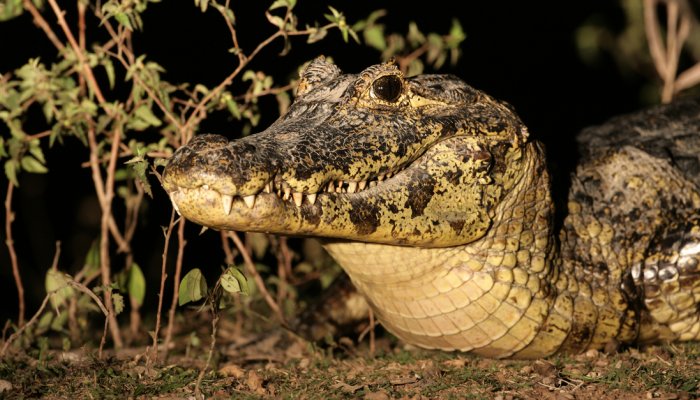
SPECTACLED CAIMAN
Much like spectacled bear, the spectacled caiman appears to be wearing a pair of glasses and, as such, received its name. It’s the bony ridge that lies between the front of its eyes that makes them appeared to be joined as if by glasses rather than coloration around the eyes. It is also known as the common or brown caiman, and they extend from northern South America to Central America and even to the Caribbean. Like other crocodiles, they prefer the slow moving water of rivers, marshes, and bogs. If you happen to see one submerged in the murky water, you can recognize them by the yellow and black crossbands that splash across their olive and grey coloring.
The spectacled caiman is relatively small for a crocodile, reaching males only 8-9 feet in length. With their smaller size, they also consumer smaller prey including birds, fish, insects, and small amphibians and mammals.
If the spectacled caiman’s environment becomes too harsh for comfort, they have the capability to tunnel into the mud and estivate, a process that can be understood as summer hibernation. When estivating, an animal can become dormant in order to survive through a hot, harsh season where food sources are lacking.
FUN FACT:
Recent studies have shown that the spectacled caiman can reflect a bright red color when subject to light. This makes the spectacled caimans easier to spot in the dar.
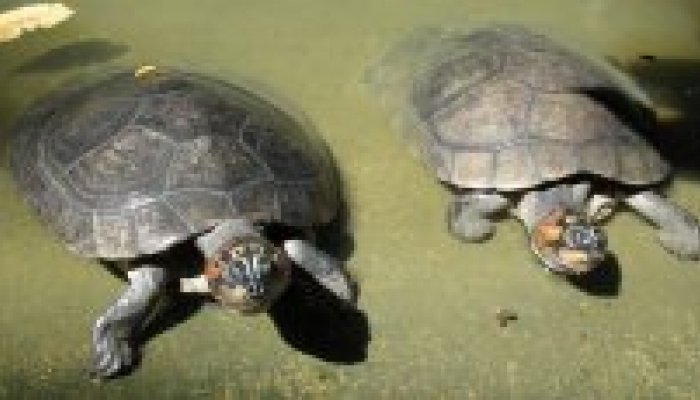
GIANT SOUTH AMERICAN RIVER TURTLE
The South American river turtle is one of the Amazon’s river turtle species, and it is known as being one of the world’s largest freshwater turtles. At least on their home continent, they are the largest turtles around. Females are much larger than their male counterparts, with their shells reaching over 30 inches compared to the male’s average 19-inch shell. The females can weigh around 200 pounds.
These flat shelled turtles are highly aquatic; they are skittish on land and more comfortable in the water. As such, they rarely emerge from the water to bask in the sun. They are also highly communal and prefer to live in groups. The giant South American river turtles even take turns cleaning algae and moss off each other’s shells to ensure that they are all looking their best.
The giant South American river turtle is native to various areas throughout the Amazon basin and South America. As such, they carry many names: Venezuelans call them the arrau; in Colombia and Peru they are known as charapa; in Brazil they are called tartaruga and tartaruga da Amazonia.
FUN FACT:
The South American river turtle, historically, are social creatures who gather in groups that can range of a group of ten to a group of over a hundred or even a thousand. Unfortunately, this ingrained behavior made them easy pickings for poaching. Their eggs and hatchlings were also prized by poachers, and at the height of harvesting around 48 million eggs were taken every year by poachers.
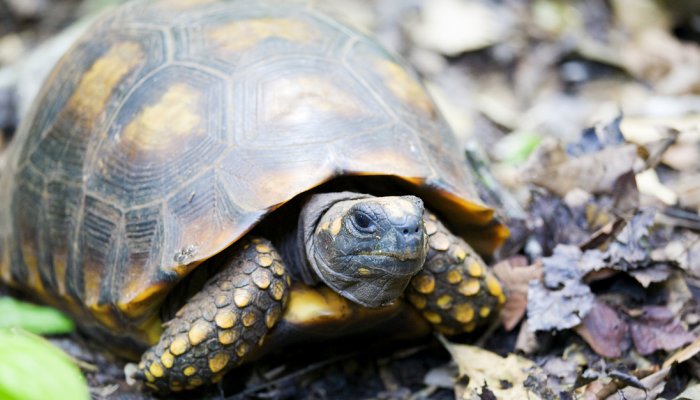
SOUTH AMERICAN YELLOW-FOOTED TORTOISE
As the South American yellow-footed tortoise’s name gives away, these tortoises carry distinguishing yellow or orange scales that spot their forearms. They can be found in South America’s rain forests, ranging throughout Venezuela, Guyana, French Guiana, and Brazil and the Amazon basin regions of Colombia, Peru, Brazil, and Ecuador. Much like many other tortoises and turtles, the South American yellow-footed tortoise suffers from the predatory nature of humans. These tortoises suffer from habitat devastation, but they are also poached for their meat—which is considered a delicacy—as well as their shells. At this moment, they are considered vulnerable to extinction.
While the giant South American river turtle lays claim to being South America’s largest turtle, the South American yellow-footed tortoise gets the honor of being South America’s largest tortoise. On average, they grow to be around 15-20 pounds with males growing to an average of 16 inches and females growing up to 24-30 inches. Some exceptional tortoises can grow to over 36 inches in length and reach up to 100 pounds.
FUN FACT:
These tortoises are all about body language! They do not need their hands to form a complex sign-language. Instead, they use rapid head movements to communicate with each other.
As they mate year round, males are always on the lookout for a receptive female. They distinguish male from female by looking out for head movements. Males greet each other with mutual responsive head motions in their own version of the “bro nod,” but if the males find themselves ignored by an uncommunicative turtle, the male assumes the tortoise is a female. Apparently, these male tortoises find the qualities of being silent and still attractive in their potential female mates.
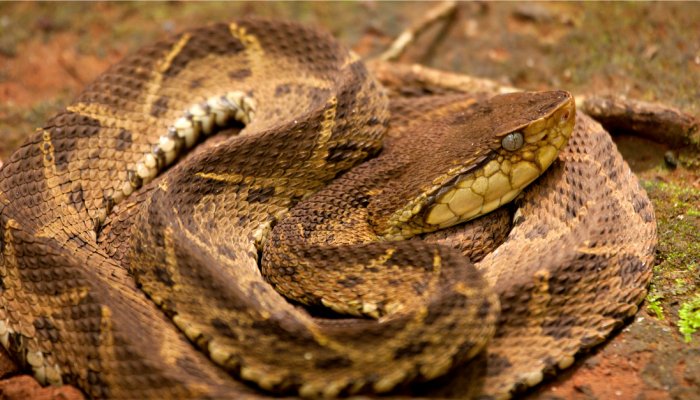
FER-DE-LANCE
Fer-de-lances are venomous vipers with a combative, deadly strike and impressive size. Meaning ‘spearhead’ in French, the fer-de-lance’s name gives warning of the snake’s formidable aim. Living in forested areas throughout the Amazon as well as banana plantations, their coils can easily be camouflaged among the surrounding environment.
The fer-de-lance is recognized as a pit viper as a deep, heat-detecting pit lies visibly between each eye and nostril. Its scales are also distinctly recognizable with their pale yellow to cream bands that crisscross the snake’s back and sides to ultimately create a diamond pattern. The snake also receives its name ‘spearhead’ in reference to its sizable triangularly shaped head, much larger than the size of its neck, that can resemble the shape of a spear.
The fer-de-lance is widely adapted throughout Central and South America. Their widespread populations are potentially unfortunate for humans, who suffer more deaths at the bite of this particular viper than any other snake.

